Archaeological Museum Gwalior
Archaeological Museum Gwalior is located on the hill of Saint Gwalipa in front of Hathi Paur gate of the fort. This museum was established in 2nd Oct, 1993 in the hospital and Jail building of the British period. The Museum Building comprises a Big Hall, a room adjacent to it and two verandahs one in front and another is on the rear side in which there are Galleries No. 1, 2, 4 and 3 respectively. Displayed sculptures in these galleries are ranging from 1" Century BC. to 17th century A.D. These sculptures have been collected from Gwalior and its adjoining districts, in which the main sites are Amrol, Kherat, Ater, Naresar, Batesar, Mitawali, Padhawali, and Sihonia, Terahi and Surwaya.
The sculptures found from Mitawali belong to Sunga and Kushan Period (1" century BC to 3rd century AD). These are life size and colossal sculptures, loaded with heavy garments and ornaments. All these sculptures are partially executed, showing the various stages of execution. Lakulisa, Harihar, Balaram and Karttikeya are the main sculptures of this period.
The sculptures found from Naresar, Batesar, Kherat, Ater, Ranod, Surwaya and Padhawali are of Gurjara Pratihara Period (from 7th century A.D. 10th century A.D.). These sculptures show the later development of Gupta Art discerned from the sculptural art, style and subject. These sculptures are executed with new spirit, which are more refined than the sculptures of later Gupta Period. While executing the female sculptures the sculptor had emphasized delicacy of body, charm tenderness and sensuous grace. The main sculptures include Nataraja, Ekmukha-Shivalinga, Mahapasupatinath, Shivalinga, Saptamatrikas, Jain Tirthankara Adinath and Parsvanath, heads of Vishnu, Ganga, Yamuna along with the doorjambs decorated with five dwarashakhas.
The sculptures found from Sihonia are very light and dynamic. These sculptures clearly show the influence of later Pratihara Art. The sculptures carry a divine and attractive from with various postures and decorations. They are really praiseworthy and have an important place in the contemporary art. The sculptures include the figures of various deities-astadikpalas, surasundaries, dancers, vidyadharas, male and female-couples in embracing postures etc. The figures found from here of Simha, Aswa, Varah, Suka and Naravyala are the symbol of power of the Kachhapaghata rulers.
The sculptures of Bhadoria Rulers of 17th Century AD found from Ater and displayed in Gallery-3 are main attraction. The sculpture shows the life style of Bhadoria Kings beside the synthesis of Hindu and Mughal Art which is an off-shoot of Mughal Art encouraged by the local Bhadoria Kings. These sculptures are polished and treated with red and green colours to make it alive.
पुरातत्व संग्रहालय ग्वालियर
पुरातत्त्व संग्रहालय, ग्वालियर दुर्ग, ग्वालिप नामक साधू की पवित्र पहाड़ी पर दुर्ग के हाथी पौर गेट के सामने स्थित है। इस संग्रहालय की स्थापना 02 अक्टूबर 1993 में हुई थी। वर्तमान संग्रहालय का यह भवन ब्रिटिश शासन काल के दौरान अंग्रेजों का अस्पताल (चिकित्सालय) तथा कारागृह था।
संग्रहालय के मुख्य भवन में एक आयताकार कक्ष एवं इससे लगा हुआ एक अन्य कक्ष तथा दो बरामदे, एक आगे तथा एक पीछे है। इन्हीं कक्षों तथा बरामदों को क्रमशः वीथिका सं. 1, 2, 4 तथा 3 नाम दिया गया है। इन वीथिकाओं में प्रदर्शित तथा सुरक्षित मूतियाँ ग्वालियर तथा उसके आस-पास के ऐतिहासिक स्थलों जैसे-अमरोल (जिला ग्वालियर), खोराट (जिला भिण्ड), नरेसर, बटेसर, मितावली, पढ़ावली, सिहोनिया (जिला मुरैना), तेरही तथा सुरवाया (जिला शिवपुरी) आदि से प्राप्त हुई हैं। ये प्रतिमाएँ प्रथम शताब्दी ई.पू. से 17वीं शताब्दी ई. तक की कला परम्परा एवं तकनीकि को दर्शाती हैं।.
मितावली से प्राप्त मूर्तियाँ शुंग तथा कुषाण काल (प्रथम शताब्दी ई.पू. से तृतीय शताब्दी ई.) की है। ये मूर्तियाँ मानवाकार अर्थात एक जीवित व्यक्ति के बराबर एवं भीमकाय तथा वस्त्र तथा गहनों से युक्त हैं। इनमें से अधिकांश मूर्तियाँ अधूरी हैं और निर्माण के विभिन्न चरणों को प्रदर्शित करती हैं। इस काल से मुख्यतः हरिहर, बलराम तथा कार्तिकेय की मूर्तियाँ प्राप्त हुई हैं।
नरेसर, बटेसर, खेराट, अटेर, रनौद, सुरवाया तथा पढ़ावली से प्राप्त मूर्तियाँ गुर्जर प्रतिहारकाल (7वीं शताब्दी ई. से 10वीं शताब्दी ई.) की हैं। ये प्रतिमाएँ गुप्तोत्तरकाल की मूर्ति निर्माणकला, तकनीक तथा विभिन्न विषयों को दर्शाती हैं। गुप्तकाल में मूर्ति निर्माण अपनी उत्कर्ष अवस्था में था जिसकी पुनरावृत्ति इस काल में हुई है। तदानुसार ये प्रतिमाएँ पतली, कमनीय, आकर्षक तथा दैवीय प्रतीत होती हैं। स्त्री-आकृतियों के निर्माण में मूर्तिकार ने शारीरिक कमनीयता, कोमलता तथा विषय परायणता पर बल दिया है। इसकाल की मुख्य प्रतिमाओं में नटराज, एकमुख शिवलिंग, महापशुपतिनाथ शिवलिंग, सप्तमातृका युक्त प्रवेशव्दार पर गंगा-यमुना की आकृतियाँ इत्यादि हैं।
सिहोंनिया से प्राप्त कच्छपघात कालीन मूर्तियाँ काफी वास्तविक, गतिशील तथा आकर्षक हैं। इन प्रतिमाओं पर उत्तर प्रतिहार कालीन कला का प्रभाव स्पष्ट दिखाई देता है, जो देवत्व, अनेक भाव-भंगिमाओं तथा अलंकरण से युक्त अत्यन्त आकर्षक हैं। ये मूर्तियाँ निःसन्देह की प्रशंसनीय तथा अपने समकालीन अन्य कलाओं में महत्वपूर्ण स्थान रखती हैं। इन प्रतिमाओं में अष्टदिक्पाल, सुरा-सुंदरी, नृत्य प्रतिमाएँ, विद्याधर तथा मिथुन-आकृतियाँ इत्यादि सम्मलित हैं। सिंह के अतिरिक्त अश्व, वराह, सुक (तोता) तथा नर-व्याल की मूर्तियाँ भी सिहोंनिया से मिली हैं, जो कच्छपघात शासकों की शक्ति का प्रतीक हैं।
संग्रहालय एक अन्य मुख्य आकर्षण अटेर से प्राप्त भदौरिया शासकों की मूर्तियाँ (1700 ई.) हैं, जो वीथिका सं. 3 में प्रदर्शित हैं। ये प्रतिमाएँ भदौरिया शासकों की जीवन शैली को प्रदर्शित करती हैं। इनका निर्माण हिन्दू एवं मुगल कला के समिश्रण शैली के रूप में हुआ हैं जो मुगल कला का ही एक अंग है तथा यह कला भदौरिया शासकों के संरक्षण में पल्लवित एवं पुष्पित हुई थी। इन मूर्तियों को सजीवता प्रदान करने के लिए चमकदार पॉलिश तथा लाल एवं हरे रंगो का प्रयोग किया गया था।
Master Pieces of Archaeological Museum Gwalior
पुरातत्व संग्रहालय ग्वालियर के मुख्य पुरावशेष
Umamaheshwar
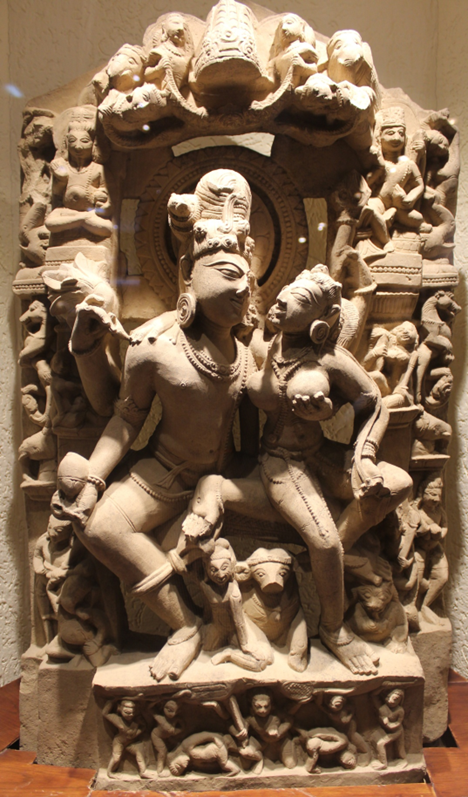
Acc No. - 1550
Name of Object - Umamaheshwar
Period - Circa 9th century A.D.
Dynasty/Style - Pratihara
Provenance - Batesar (District Morena)
Material - Coarse grained sandstone
Displayed – Gallery No. 1
Description:- Four armed Siva is shown seated in lalitasana carrying a nilotpala and a trident in both his upper hands while Uma is siting on his left leg. Her left leg rests on her mount lion. Nandi and rishi bhrigni are shown in between the deties. In upper part Brahma and Vishnu are shown siting on right and left side of the deities. While in lower part Ganesh and kartikeya are shown on right and left respectively. On the extreme end of the sculpture a chauribearer Gajavyal and makar and warrior are shown in ascending order.
उमा महेश्वर

पंजीयन संख्या . 1550
पुरावशेष का नाम - उमा महेश्वर
काल -9 वीं शताब्दी ई.
राजवंश/शैली - प्रतिहार
प्राप्ति स्थल - बटेसर (जिला मुरैना)
विवरणः- चतुर्भुज शिव को ललितासन में बैठे हुए दिखया गया है उनके दोनों ऊपरी हाथों में नीलोत्पल और त्रिशूल है, जबकि उमा उनके बांए पैर पर बैठी हैं। उनका बांया पैर उनके वाहन सिंह पर टिका हुआ है देवताओं के बीच में ऋषि भृग्नि को दिखाया गया है। ऊपरी भाग में ब्रह्मा और विष्णु को देवताओं के दाईं और बाईं ओर बैठे दिखाया गया है। जबकि निचले हिस्से में गणेश और कार्तिकेय को क्रमशः दाएं और बाएं दिखाया गया है। मूर्ति के अंतिम छोर पर एक छोरी धारक गजव्याल और मकर और योद्धा का आरोही क्रम में दर्शाया गया है।
Birth of Krishna
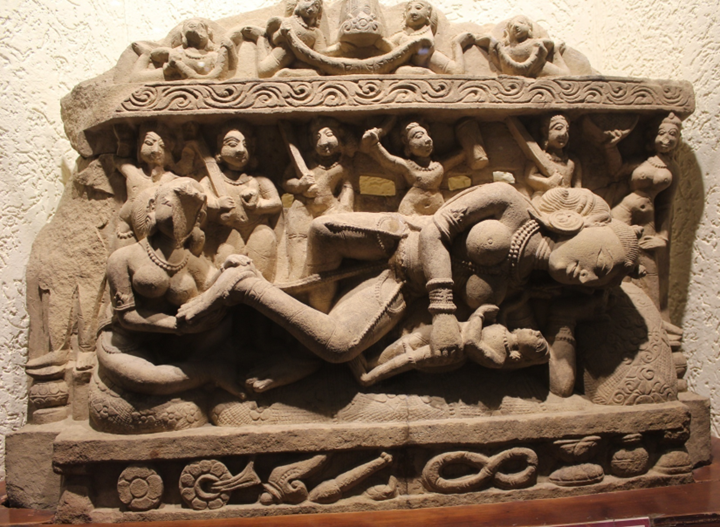
Acc No. - 1551
Name of Object - Birth of krishna
Period - Circa 9th century A.D.
Dynasty/Style - Pratihara
Provenance - Batesar (District Morena)
Material - Coarse grained sandstone
Displayed – Gallery No. 1
Description:- The unique presentation of birth of Krishna is shown Devaki, feeding her new born baby. At the back guards are shown holding weapons. The usual attributs of Vishnu are shown at the pedestal.
कृष्ण जन्म

पंजीयन संख्या . 1551
पुरावशेष का नाम - कृष्ण जन्म
काल - 9 वीं शताब्दी ई.
राजवंश/शैली - प्रतिहार
प्राप्ति स्थल - बटेसर (जिला मुरैना)
विवरणः- कृष्ण जन्म की अनूठी प्रस्तुति में देवकी को अपने नवजात शिशु को स्तनपान कराते हुए दिखाया गया है। पीछे की ओर हाथों में आयुध जिये रक्षकों का अंकन है पीठिका पर विष्णू के आयुधों को दिखाया गया है।
Balaram
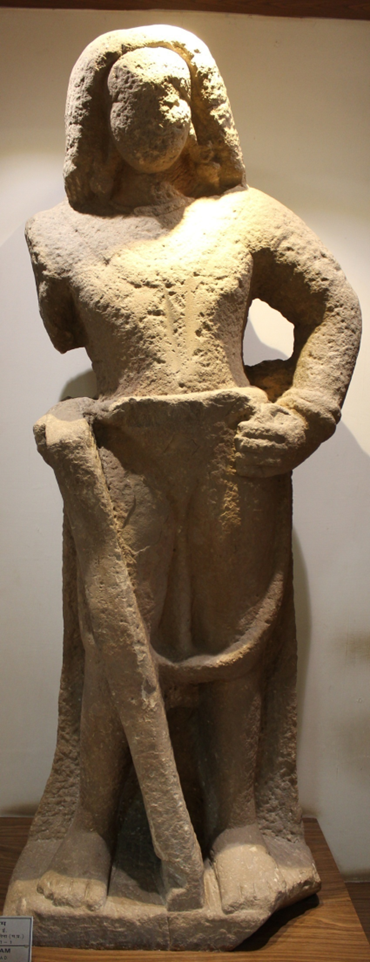
Acc No. - 01
Name of Object - Balaram
Period - Circa 1st century A.D.
Dynasty/Style - Kushana style
Provenance - Mitawali, District Morena.
Material - Coarse grained sandstone
Displayed – Gallery No. 1
Description:- The figure is in standing posture holding a plough in his right hand, the left hand is resting on his waist. He wears a necklace, elongated ear-rings, girdle, bangles, armlet and usual clothes.
बलराम

पंजीयन संख्या . 01
पुरावशेष का नाम - बलराम
काल - पहली शताब्दी ई. पू.
राजवंश/शैली - कुषाण शैली
प्राप्ति स्थल - मितावली (जिला मुरैना)
विवरणः- प्रतिमा स्थानक मुद्रा में है उनके दाहिने हाथ में हल है और बायां हाथ उनकी कमर पर है। वह एक हार, लम्बी कान की बालियाँ, करधनी, चूड़ियाँ, बाजूबंद और सामान्य वस्त्र पहने हुए है।
Apsaras
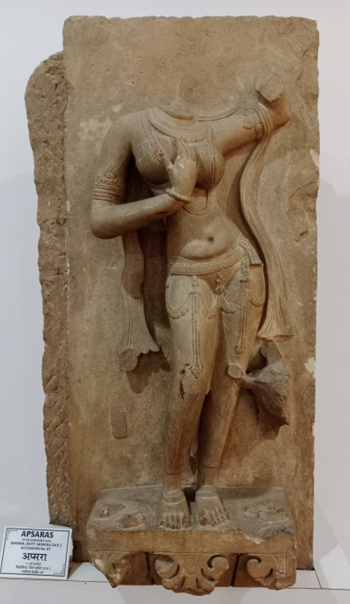
Acc No. - 87
Name of Object - Apsaras
Period - Circa 11nt century A.D.
Dynasty/Style - Prtihar
Provenance - Sihonia, District Morena.
Material - Coarse grained sandstone
Displayed – Gallery No. 2
Description:- She is standing in Tribhangamudra and is shown touching her breast with her right hand while her left hand is raised up holding a scarf. This is flying on both the sides. Her usual ornaments are very well executed. Her head and left hand are broken. Two pairs of feet of the attendants are seen on the pedestal. This is one of the masterpiece sculptures in this museum, which shows all the characteristics of a developed art of the medieval period.
अप्सरा

पंजीयन संख्या . 87
पुरावशेष का नाम - अप्सरा
काल -11 वीं शताब्दी ई.
राजवंश/शैली - प्रतिहार
प्राप्त स्थल - सिंहोनिया (जिला मुरैना)
विवरणः- अप्सरा त्रिभंग मुद्रा में खड़ी हुई दर्शायी है जो अपने दाहिने हाथ से स्तन को छू रही है तथा बायाँ हाथ से स्कार्फ को लटकते हुए दिखाया है। जो दोनो तरफ दिखाई दे रहा है। आभुषण बहुत अच्छी तरह दर्शाये गए है। इनका सिर एवं बांया हाथ टूटा हुआ है। नीचे की ओर आस-पास दो परिचारक दिखाई दे रहे है यह इस संग्रहालय की उत्कृष्ट मूर्तियांे में से एक है जो मध्यकाल की विकसित कला की सभी विशेषताओं को दर्शाती है।
Jambhala (Buddhist Kubera)
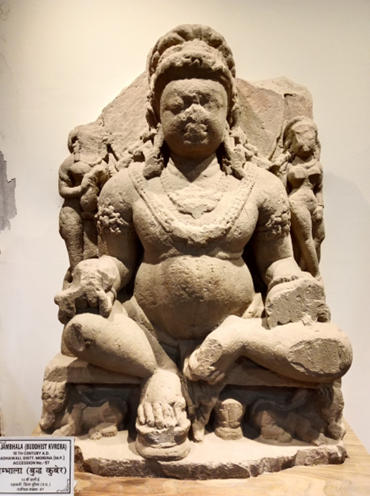
Acc No. - 57
Name of Object - Kubera
Period - Circa 10nt century A.D.
Dynasty/Style - Prtihar
Provenance – Padhawali, district Morena
Material - Coarse grained sandstone
Displayed – Gallery No. 1
Description:- Pot bellied Kubera in seated posture on lion throne wearing usual ornaments are shown. Attributes of both the hands are broken. To the left and right of the deity female attendant are shown. The attendant of right side is carrying a money beg.
जाम्भल (बुद्ध कुबेर)

पंजीयन संख्या . 57
पुरावशेष का नाम - कुबेर
काल -10 वीं शताब्दी ई.
राजवंश/शैली - प्रतिहार
प्राप्ति स्थल - पढावली (जिला मुरैना)
विवरणः- सिंहासन पर बैठे हुए पेट वाले कुबेर को सामान्य आभुषण पहने हुए दिखाया गया है। दोनो हाथ टूटे हए है देवता के बायीं और दांयी ओर महिला परिचारकों को दिखाया गया है दाहिने ओर का परिचारक धन का भिक्षापात्र लिये हुए है।